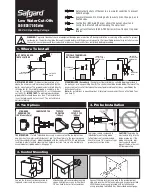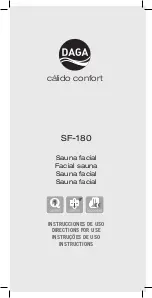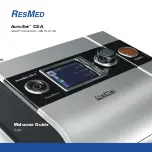
16 1-800-732-2677
1. Apply Power to the Fence Transmitter with the supplied Power Adapter.
2. Set the Boundary Width Control Switch (located on the side of the
Fence Transmitter) (
6A
) to the A, B, or C setting based on the total
length of Boundary Wire used. Setting B is used for most properties. The
following table will indicate the proper setting.
3. The width of the containment field is adjusted using the transmitter’s
Amount of Wire
Setting
Greater than 2400 feet
A
Up to 1300 feet
B
1300 to 2400 feet
C
Boundary Width Control knob. Turn the knob counter clockwise until the alarm sounds and the Loop
Indicator Light is no longer lit. Turn the knob clockwise and increase by 2 numbers. The alarm should turn
OFF and the light should turn ON.
The Receiver Collar should not be on your dog when the system is tested. Your pet may receive an
unintended correction.
4. Place battery in Receiver Collar. To identify the Warning and Static Correction Zones make sure the Receiver
Collar is set at level 5 (see Step 5).
5. Test the Boundary Width of the system by selecting a section of straight Boundary Wire that is at least 50 feet
long. Start inside the center of the containment field.
6. Place the Test Light Tool Contacts on the Contact Points on the
Receiver Collar (
6B,6C
). Hold the Receiver Collar at your dog’s
neck height with the Contact Points pointing up (
6D
) and the
Correction Level Button facing the Boundary Wire. Slowly walk
toward the Boundary Wire until you hear the warning tone
(
6E
). When you hear the warning tone, you have identified
the Boundary Width distance (Static Correction Zone). Two
seconds after the warning tone, the test light will begin to
flash. This flashing light can aid you in identifying the
Test Light Contacts
6B
6C
Boundary Width should you have difficulty hearing the tone. To avoid
having the Receiver Collar go into Over Correction Protection mode,
walk back into the Pet Area until the toning stops. If the Receiver
Collar does not tone at the desired range, adjust the Boundary Width
Control knob to obtain the desired range. Turning the Boundary
Width Control knob clockwise increases the Boundary Width while
turning it counterclockwise decreases it (
6F
). Repeat this activity as
needed until the Receiver Collar tones between 6 to 10 feet from
the Boundary Wire. If using a Double Loop layout, you may need to
increase the separation of the Boundary Wire and/or increase the size
of the Boundary Width to achieve the desired range.
6D
Boundary
Wire
6E
7. Test in a number of different locations around the containment area until you are
satisfied that the system is functioning properly.
8. Next, walk all around the Pet Area to ensure there are no areas where the Receiver
Collar may activate from signals coupled onto buried wires or cables. Test the collar
in and around the inside of the house as well. As mentioned, cable and wires from
cable TV, electrical or telephone lines may conduct pet fencing signals inside and
outside the house that can activate the dog’s collar accidentally. While rare, if this
occurs your Boundary Wire is probably too close to these outside lines and should
be moved or modified as shown in Figure (
3A
).
5
2
8
4
10
3
9
1
7
0
6
5
2
8
4
10
3
9
1
7
0
6
6F
Содержание PIG00-10777
Страница 31: ...petsafe com 31 Layout Grid...
















































